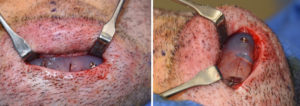Background: The shape of the lower jaw has a major influence on the appearance of the lower face. The lower jaw is an L-shaped bone composed of the vertical ramus posteriorly and the horizontal body and chin which protrudes anteriorly. Much the forward growth of the lower jaw emanates from the condylar growth center in front of the ear which drives down the length of the ramus. When the lower jaw is underdeveloped, as seen by a chin weakness, the vertical length of the ramus can be shortened resulting in a high jaw angle or high mandibular plane angle.
In the high or steep mandibular plane angle patient, the chin may not have adequate forward projection. But it may also be prone to being on the edge of being a touch vertically long. When considering chin augmentation in the high mandibular plane angle patient, it is important to be vigilant about the vertical chin length. Some of these patients may be fine with pure horizontal augmentation and some may even need to be vertically shortened as the chin is moved forward.
Many patients that present for custom jawline implants have a prior history of chin and jaw angle implants and/or orthognathic surgery or a sliding genioplasty. Some of the implant patients seeking a custom approach because of misadventures using standard implants while others have discovered the limitation of what standard implants can do for the jawline augmentation. The following case represents the former which magnified the naturally long chin in the high mandibular plane angle patient.



Case Highlights:
1) High plane angle jaws (high jaw angles with a long chin) create an unaesthetic vertical facial elongation.
2) The low positioned chin implant magnifies the facial elongation effect of a high plane angle jaw.
3) Removal of a malpositioned chin implant and placement of a custom jawline implant can derotate the high plane angle lower jaw.
Dr. Barry Eppley
Indianapolis, Indiana






